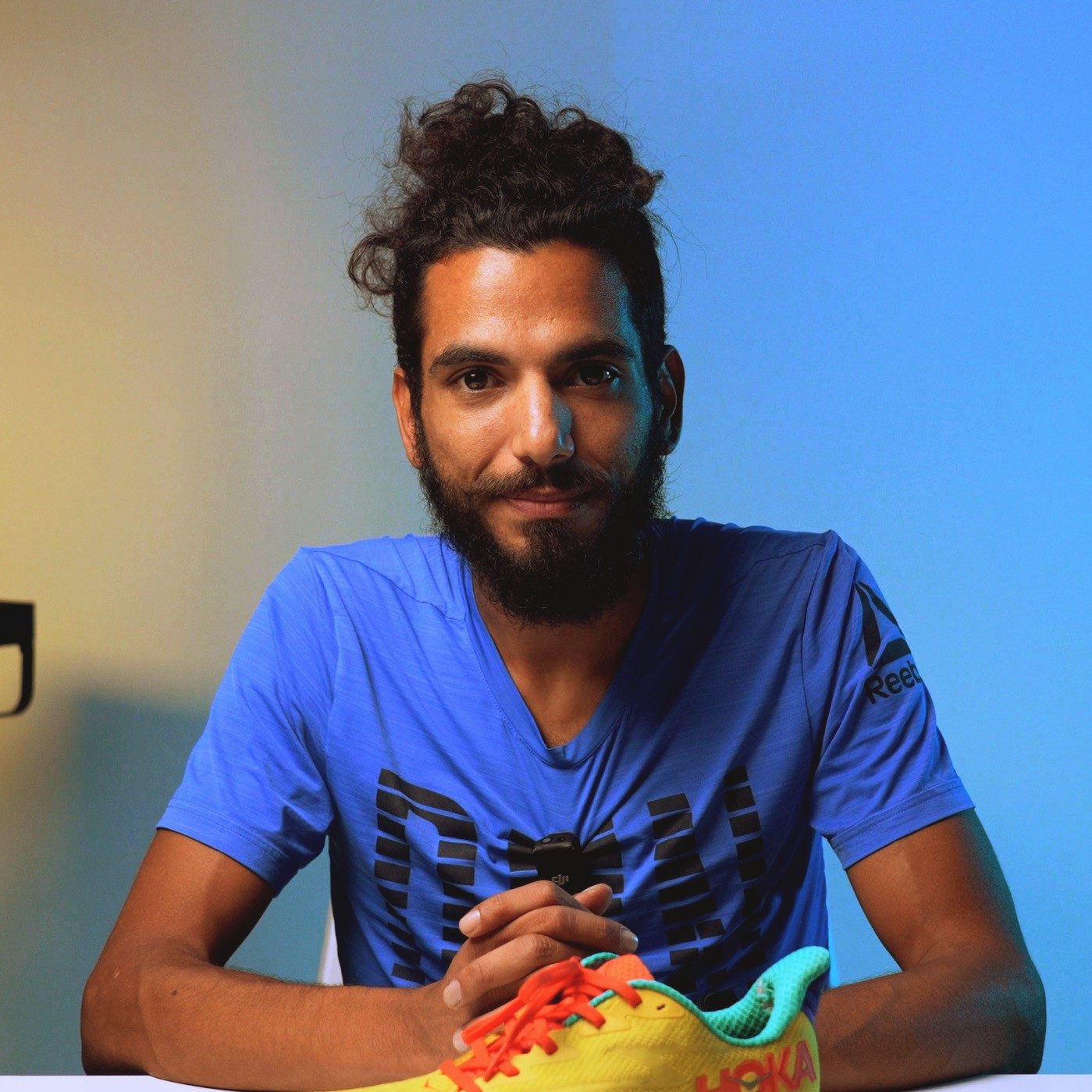Our verdict
- Top pick in best cheap running shoes (2023)
Pros
- Great impact protection
- Bounce midsole foam at the heel provides a premium feeling ride
- Good for walking, gym days, as well as easy runs
- Remarkably stable underfoot
- Grippy and durable outsole
- Budget friendly
- Stylish and sustainable design
Cons
- Very heavy for a road shoe
- Breathability could be better
- Tapered toebox
- Lacking in upper durability
Audience verdict
Comparison
The most similar running shoes compared
+ + Add a shoe | |||||
|---|---|---|---|---|---|
| Audience score | 80 Good! | 89 Great! | 86 Good! | 90 Superb! | |
| Price | $100 | $130 | $105 | $180 | |
| Pace | Daily running | Daily running | Daily running | Daily running | |
| Shock absorption | - | High | Moderate | Moderate | |
| Energy return | - | Low | Low | High | |
| Traction | - | Moderate | Moderate | High | |
| Arch support | Neutral | Neutral | Neutral | Neutral | |
| Weight lab Weight brand | 12 oz / 340g 12.5 oz / 354g | 9.7 oz / 274g 9.5 oz / 270g | 10.4 oz / 295g 10 oz / 283g | 10.3 oz / 292g 11.4 oz / 323g | |
| Drop lab Drop brand | 11.5 mm 10.0 mm | 10.5 mm 5.0 mm | 12.3 mm 10.0 mm | 10.6 mm 10.0 mm | |
| Strike pattern | Heel | Heel | Heel | Heel | |
| Size | True to size | True to size | True to size | True to size | |
| Midsole softness | Balanced | Soft | Soft | Soft | |
| Difference in midsole softness in cold | Small | Normal | Normal | Small | |
| Toebox durability | Bad | Bad | Decent | Decent | |
| Heel padding durability | Bad | Decent | Good | Good | |
| Outsole durability | Good | Good | Good | Good | |
| Breathability | Moderate | Breathable | Moderate | Breathable | |
| Width / fit | Medium | Medium | Narrow | Wide | |
| Toebox width | Narrow | Medium | Medium | Wide | |
| Stiffness | Stiff | Moderate | Moderate | Stiff | |
| Torsional rigidity | Stiff | Stiff | Stiff | Stiff | |
| Heel counter stiffness | Moderate | Stiff | Moderate | Moderate | |
| Heel lab Heel brand | 37.7 mm 20.0 mm | 40.7 mm 40.0 mm | 37.6 mm 35.0 mm | 35.2 mm 39.0 mm | |
| Forefoot lab Forefoot brand | 26.2 mm 10.0 mm | 30.2 mm 35.0 mm | 25.3 mm 25.0 mm | 24.6 mm 29.0 mm | |
| Widths available | Normal | NormalWide | NormalWideX-Wide | Normal | |
| Orthotic friendly | ✓ | ✓ | ✓ | ✓ | |
| Season | All seasons | SummerAll seasons | All seasons | SummerAll seasons | |
| Removable insole | ✓ | ✓ | ✓ | ✓ | |
| Ranking | #306 Bottom 18% | #104 Top 28% | #187 Top 50% | #51 Top 14% | |
| Popularity | #182 Top 49% | #242 Bottom 35% | #72 Top 20% | #193 Bottom 48% |
Who should buy
We recommend the alphabounce+ to:
- Beginner runners looking for a neutral road shoe
- Casual runners who want a versatile shoe that’s stylish and comfy enough for day to day use as well occasional easy runs or gym days.
- Sustainably minded individuals who will appreciate the use of recycled materials in the shoe’s upper

Who should NOT buy
The Alphabounce+ is prohibitively heavy when attempting anything beyond an easy and short run. For a daily trainer that’s more lightweight but still within a similar price range, we recommend having a look at the Brooks Revel 6 instead.
The Alphabounce+’s average level of airflow means the shoe will feel quite toasty during runs on warmer days. The Adidas Supernova 2 is a more breathable alternative.
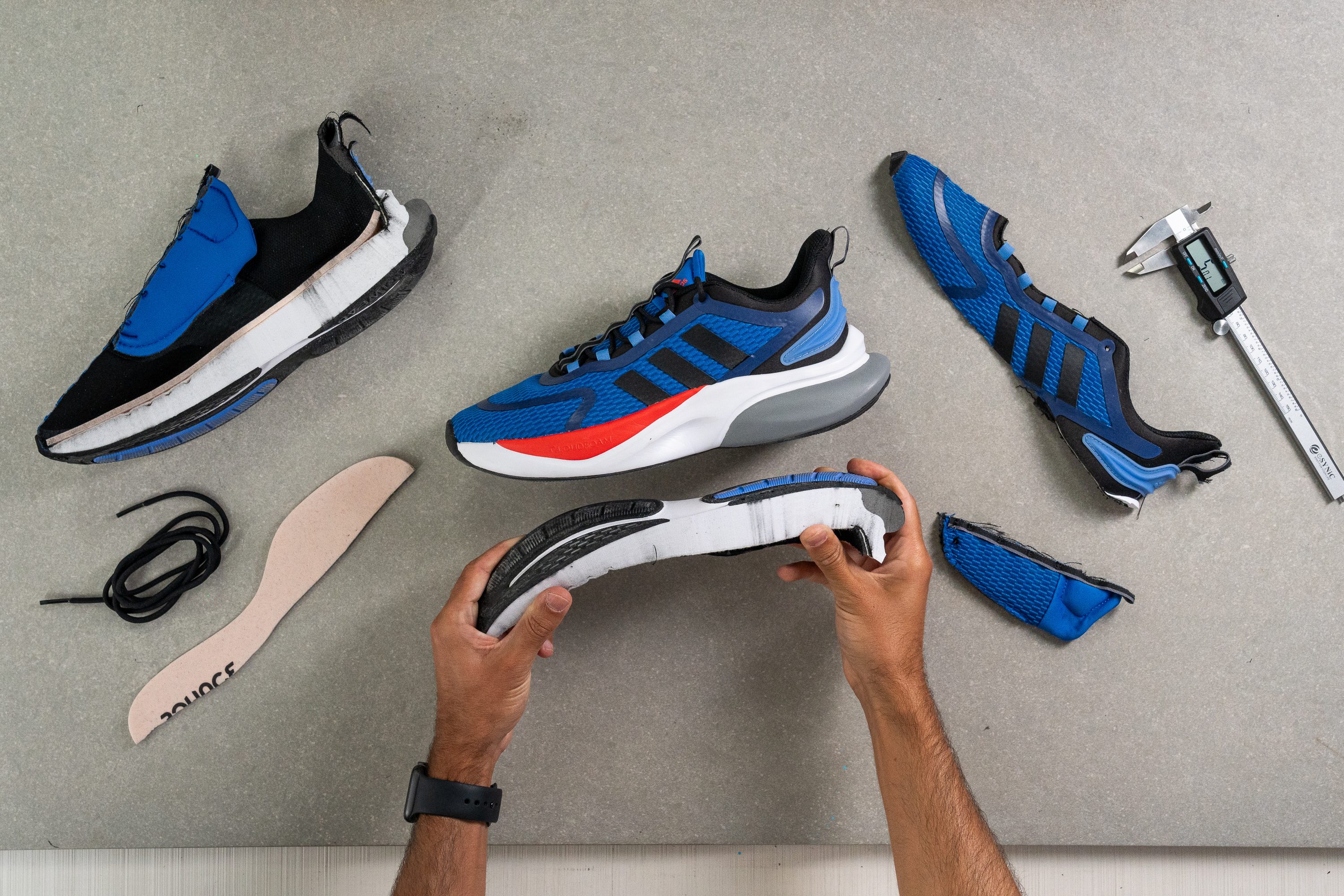
Cushioning
Heel stack
At a mighty 37.7 mm according to our caliper measurements, the Alphabounce+ boasts a heel stack that is significantly higher than our current lab average. This means that heel strikers have plenty of protective foam underfoot to savor.
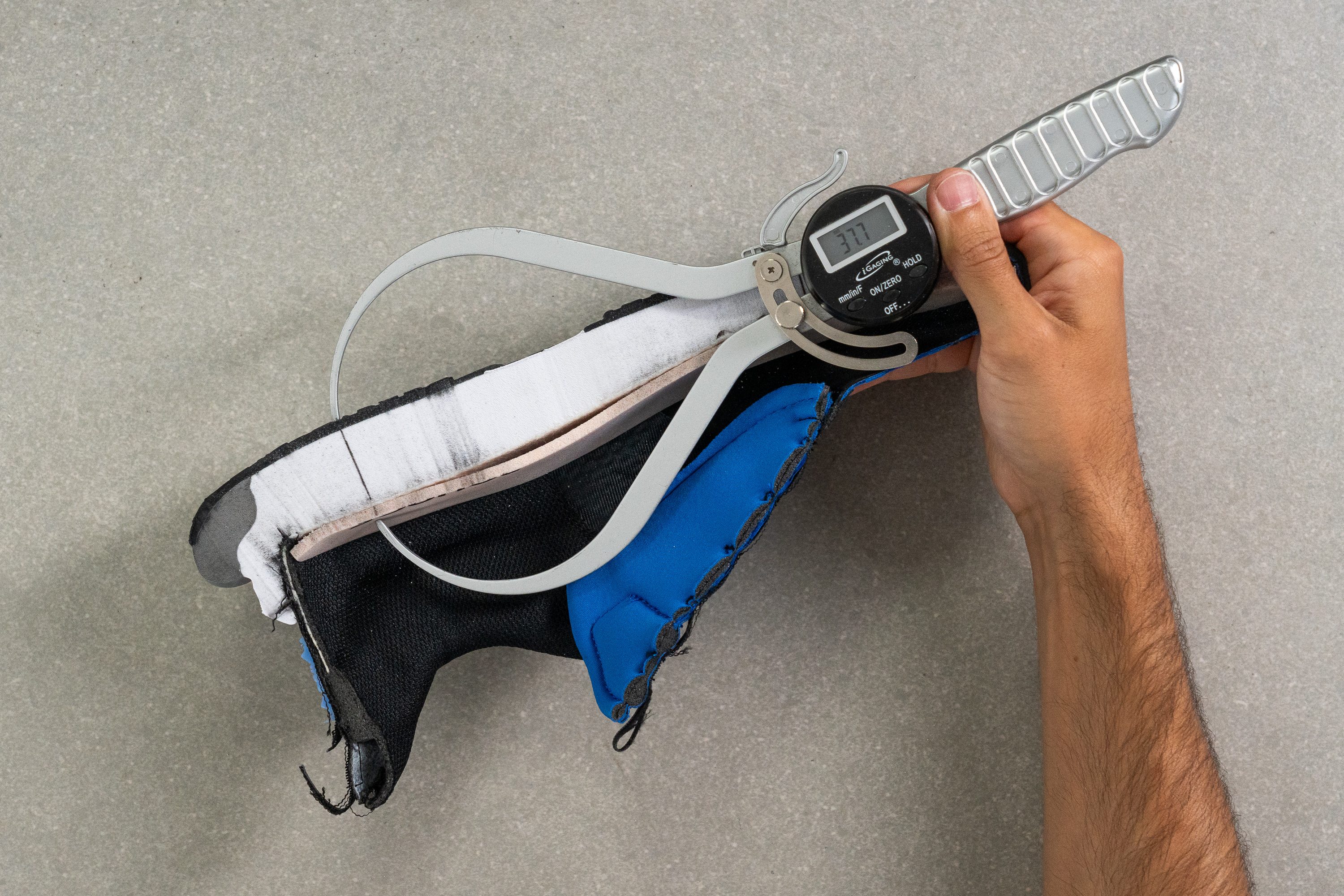
| Alphabounce+ | 37.7 mm |
| Average | 34.8 mm |
Forefoot stack
At 26.2 mm, the Alphabounce+’s forefoot stack is also higher than our current lab average. This means that forefoot strikers should also enjoy good impact protection in the shoe.
Runners who prefer more ground-feel during their runs should check out the Adidas Fluidflow 2.0 with its less robust stack instead.
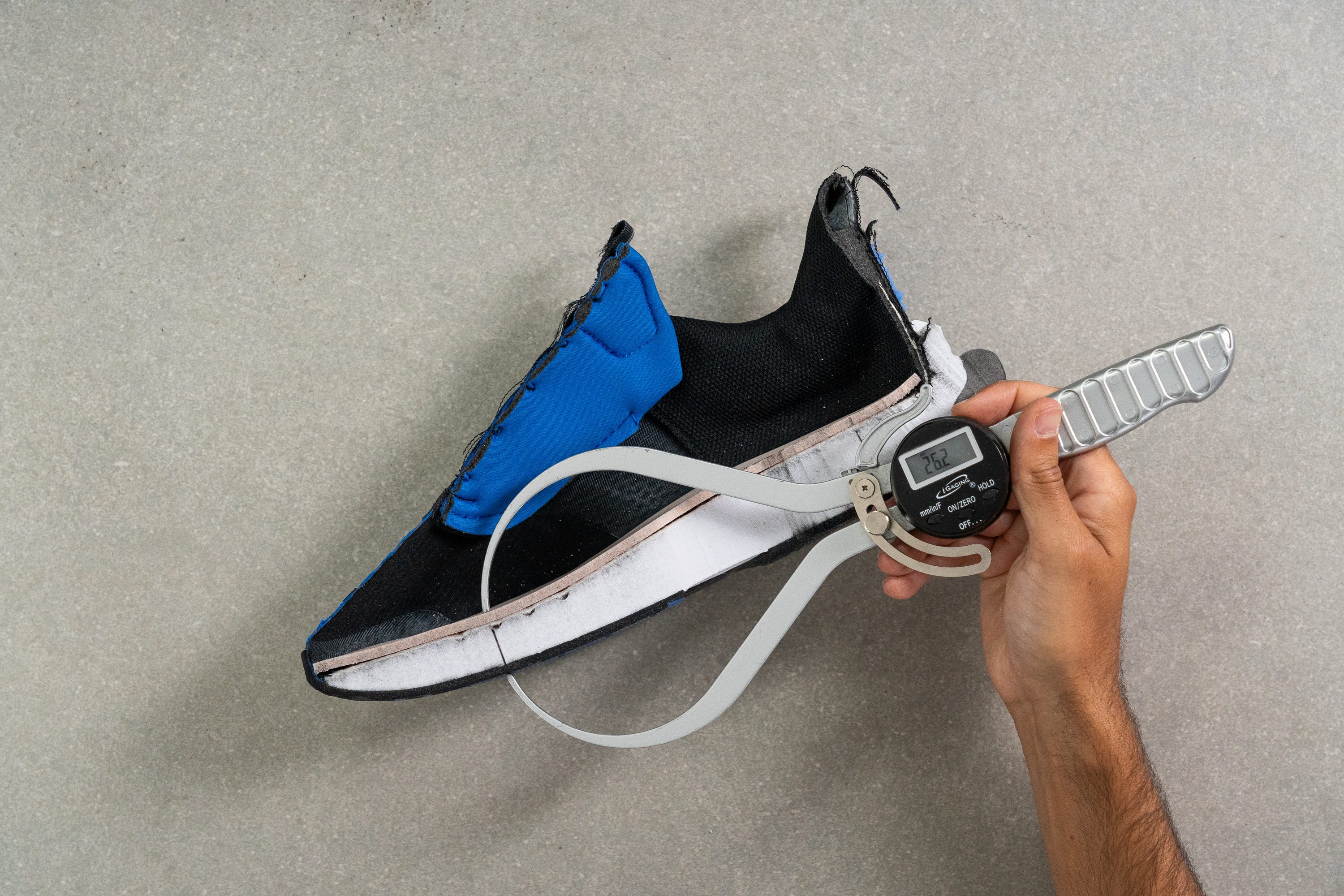
| Alphabounce+ | 26.2 mm |
| Average | 26.2 mm |
Drop
The difference in our stack height measurements leaves us with a drop height of 11.5 mm, making the Alphabounce+ fall in the category of high drop shoes. This heel drop is beneficial for beginner runners who generally have a tendency to heel strike as it promotes smooth heel-to-toe transitions. It is also good for runners who are prone to injuries in their ankles or Achilles as high drop shoes allows the knees and hips to bear the brunt of the load when running.

Those new to running should take a look at our helpful guide for a breakdown of different heel-toe drops and their effects for a better understanding of the subject.
| Alphabounce+ | 11.5 mm |
| Average | 8.6 mm |
Midsole softness
The “Bounce” midsole foam found at the heel of the Alphabounce+ gave us a durometer reading of 22.4 HA, making it just a tad softer than our current lab average. This level of softness provides us with a balanced level of cushioning for our runs, while the configuration of the Bounce foam gives it a level of elasticity and snappiness normally found in more premium road shoes. This means that heel striking runners will enjoy well protected landings and energetic transitions when taking the Alphabounce+ out for a spin.
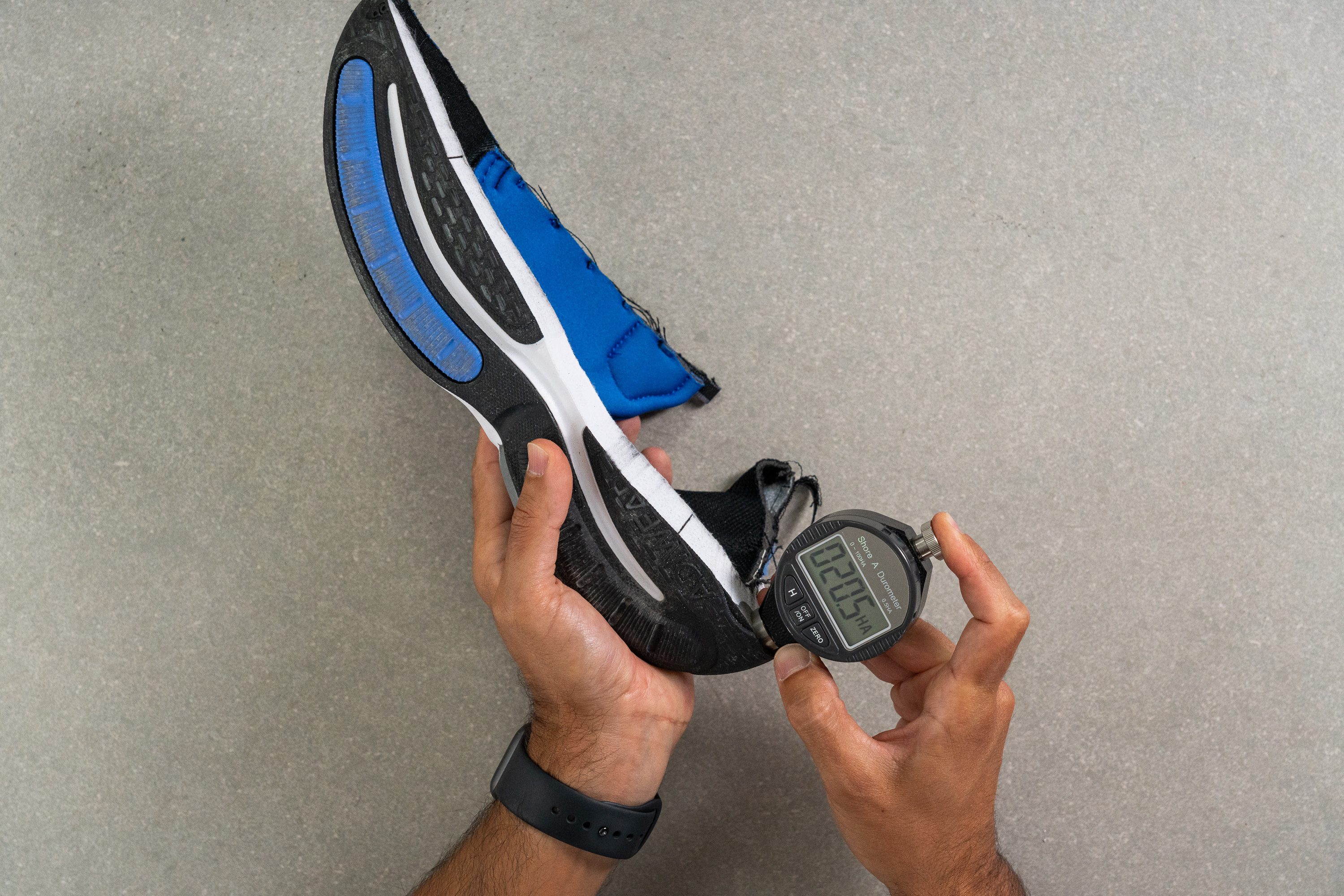

| Alphabounce+ | 22.4 HA |
| Average | 20.4 HA |
Secondary foam softness
The “Cloudfoam” material that makes up the rest of the shoe’s midsole gave us a durometer reading of 21.8 HA. Despite this only being a marginally softer result than the Bounce foam at the heel, the Cloadfoam feels decidedly more plush underfoot with the way it compresses under our weight.
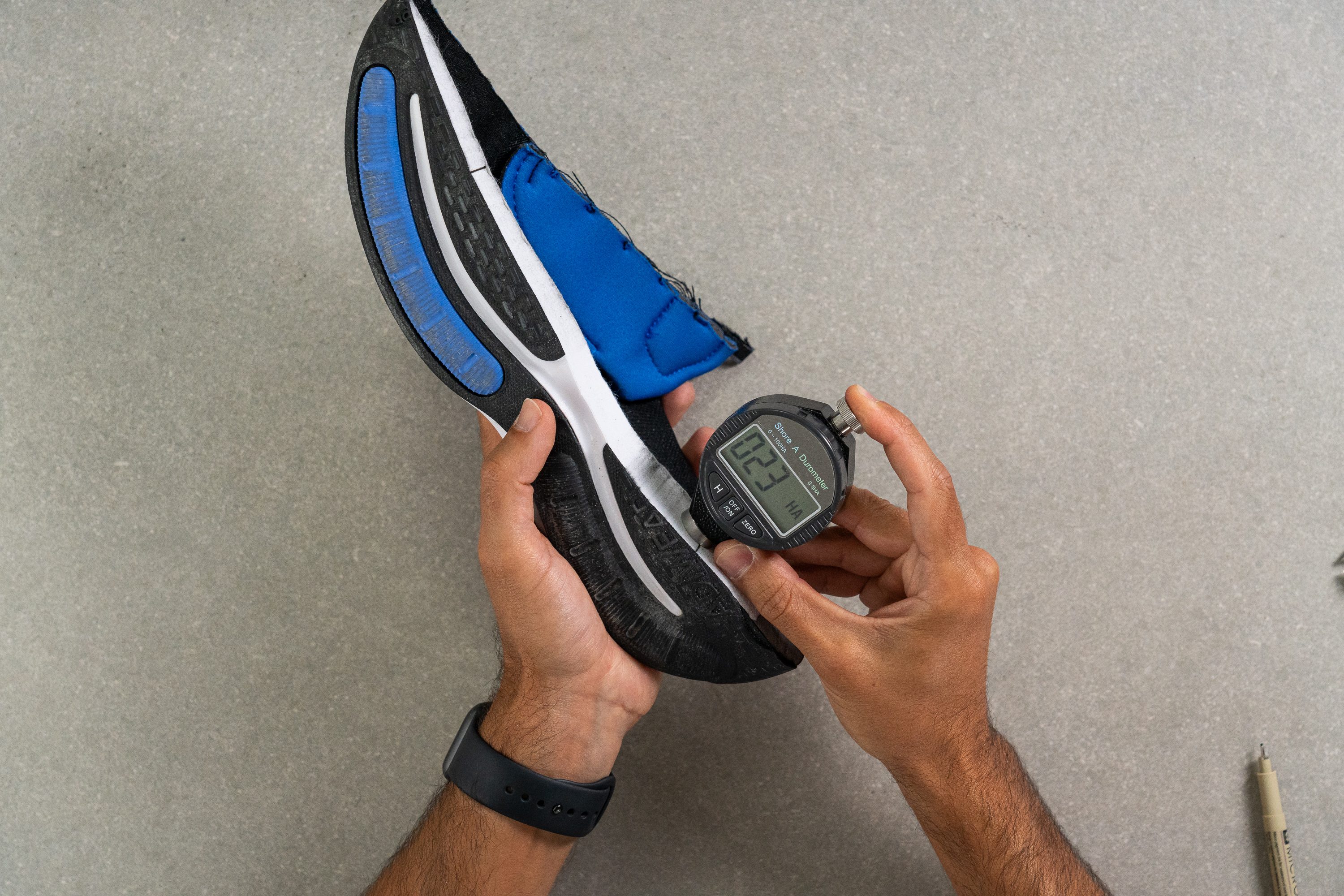
While this means that forefoot strikers will also benefit from good impact protection on landings, the Cloudfoam is much less poppy than its Bounce counterpart so the Alphabounce+ won’t feel as responsive for those runners.
| Alphabounce+ | 21.8 HA |
| Average | 22.7 HA |
Size and fit
Size
Adidas Alphabounce+ fits true to size (30 votes).
Width / Fit
We measured the Alphabounce+ at its widest point and found 96.6 mm using our caliper.
This slightly exceeds our lab’s average width, suggesting it might suit most runners. However, after testing, we’re convinced it doesn’t tell the whole story of this shoe—this is why we take three measurements instead of one, ensuring a comprehensive assessment of the shoe's fit.

| Alphabounce+ | 96.6 mm |
| Average | 95.1 mm |
Toebox width
Our second measurement, taken in the big toe area, revealed the Alphabounce+’s secrets. In fact, it’s been a while since we’ve seen such a low result in this test, measuring just 67.9 mm.
In our view, this ultra-tapered toebox ony works for runners with narrow, slim feet.
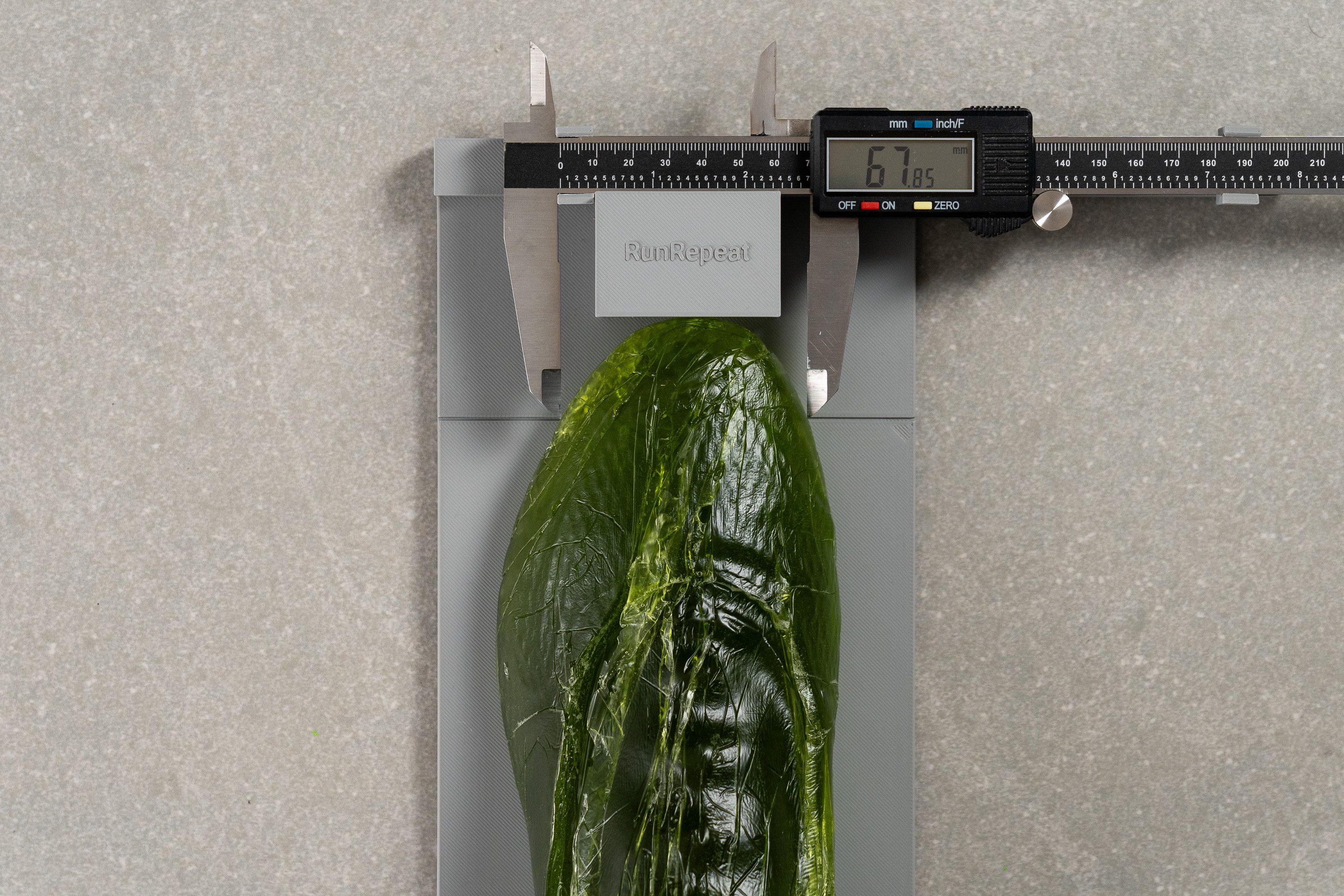
| Alphabounce+ | 67.9 mm |
| Average | 73.2 mm |
Toebox height
The upper is far from spacious, a fact confirmed by our toebox height measurement—just 25.8 mm. According to our lab data, this design falls well below the average, offering minimal vertical room.

| Alphabounce+ | 25.8 mm |
| Average | 27.1 mm |
Flexibility / Stiffness
For such a bulky shoe the Alphabounce+ is surprisingly flexible. We tested this by securing the shoe to our workbench and measuring the amount of force needed to bend the shoe 90-degrees. This yielded a result of 26.3N which is more flexible than the average shoe despite all that midsole foam.
This contributes to the Alphabounce+’s comfortable underfoot sensation as the shoe is able to bend with the natural movement of our foot without putting up too much resistance.
This test follows an older methodology, which is why you don't see recently tested shoes in the chart. Results from different methodologies can not be compared.
| Alphabounce+ | 26.3N |
| Average | 28.1N |
Stiffness in cold (%)
Even when repeating the stiffness test after leaving the shoe in our freezer for twenty minutes, it remains more flexible than the average shoe with 38.5N of force required to bend the frigid Alphabounce+. This is still quite a stiff reading and means that the Alphabounce+ will definitely feel less comfortable during harsh winters or if it’s been left outside on a cold night.
A 46% differential in the shoe’s flexibility between warm and cold conditions means that the Alphabounce+ stiffens up at about the same rate as the average shoe. This is about what we expect from a daily trainer at this price range.
| Alphabounce+ | 46% |
| Average | 33% |
Weight
At 12 Oz (340g) the Alphabounce+ is as bulky as it looks and is much heavier than the average shoe we've tested in the lab so far. While it feels somewhat lighter underfoot, the Alphabounce+ is still a lot of shoe and is far too burdensome for long distances or tempo sessions. For a more “diet” daily trainer, we recommend checking out the Brooks Revel 6 instead.

| Alphabounce+ | 12.0 oz (340g) |
| Average | 9.3 oz (264g) |
Breathability
To test the breathability of the shoe, we pumped smoke into the Alphabounce+ to observe how it vents. As we can clearly see from the video, the Alphabounce+ does allow a fair amount of smoke to escape, but that airflow seems to be localized mostly around the shoe’s tongue while the rest of the shoe seems well insulated. This less than stellar performance leads us to give the shoe a breathability score of 3 out of 5.
Shining a light through a cross-section of the Alphabounce+ reveals just how dense the upper material is. The shoe entirely blocks the light which makes it surprising that the shoe has any airflow at all.
Our mildly mesmerizing microscope shot of the upper material provides some answers to the mystery. The thick and tightly woven featherlike braids form gaps that reveal a less compact latticed mesh beneath that promotes some level of airflow through the Alphabounce+.
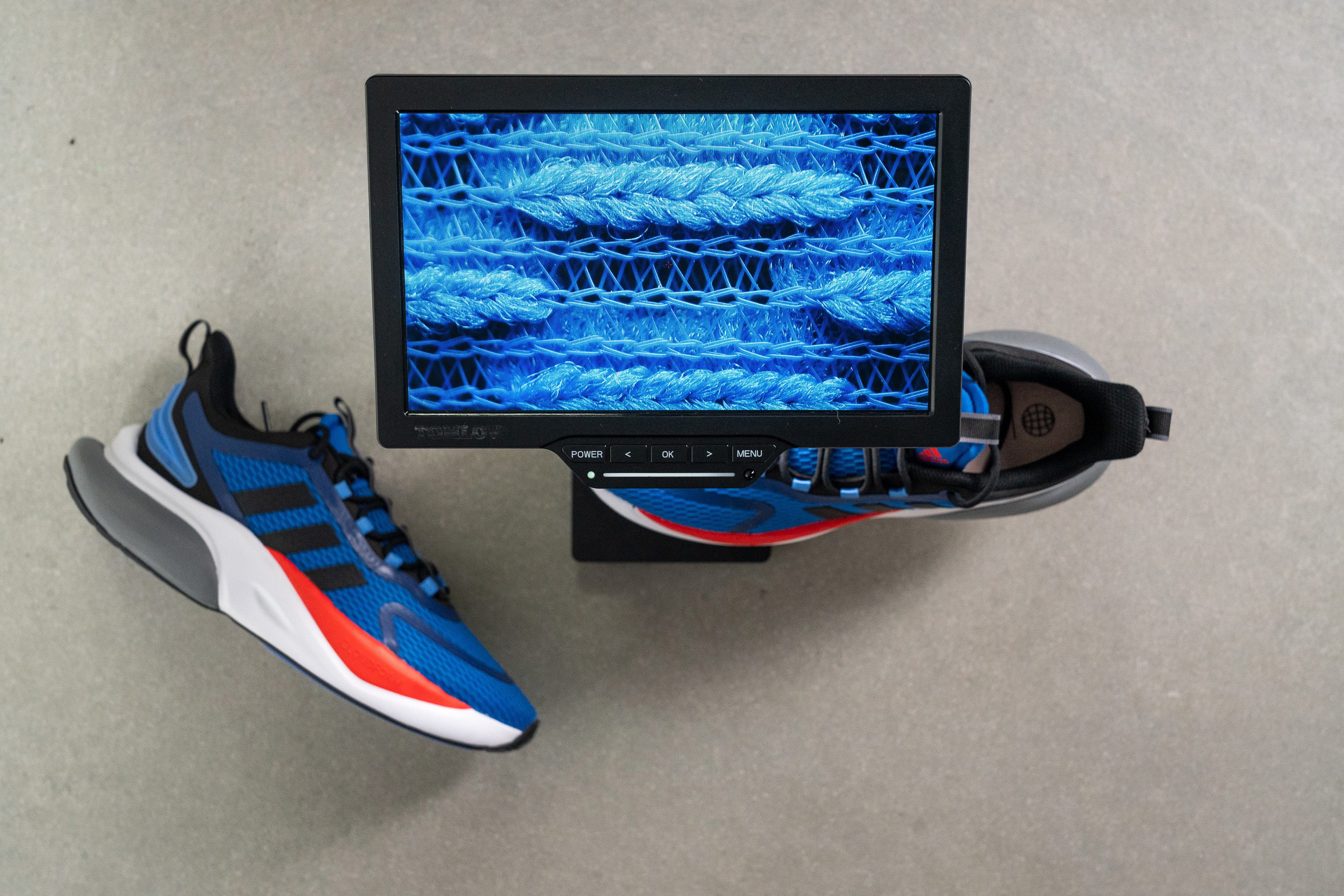
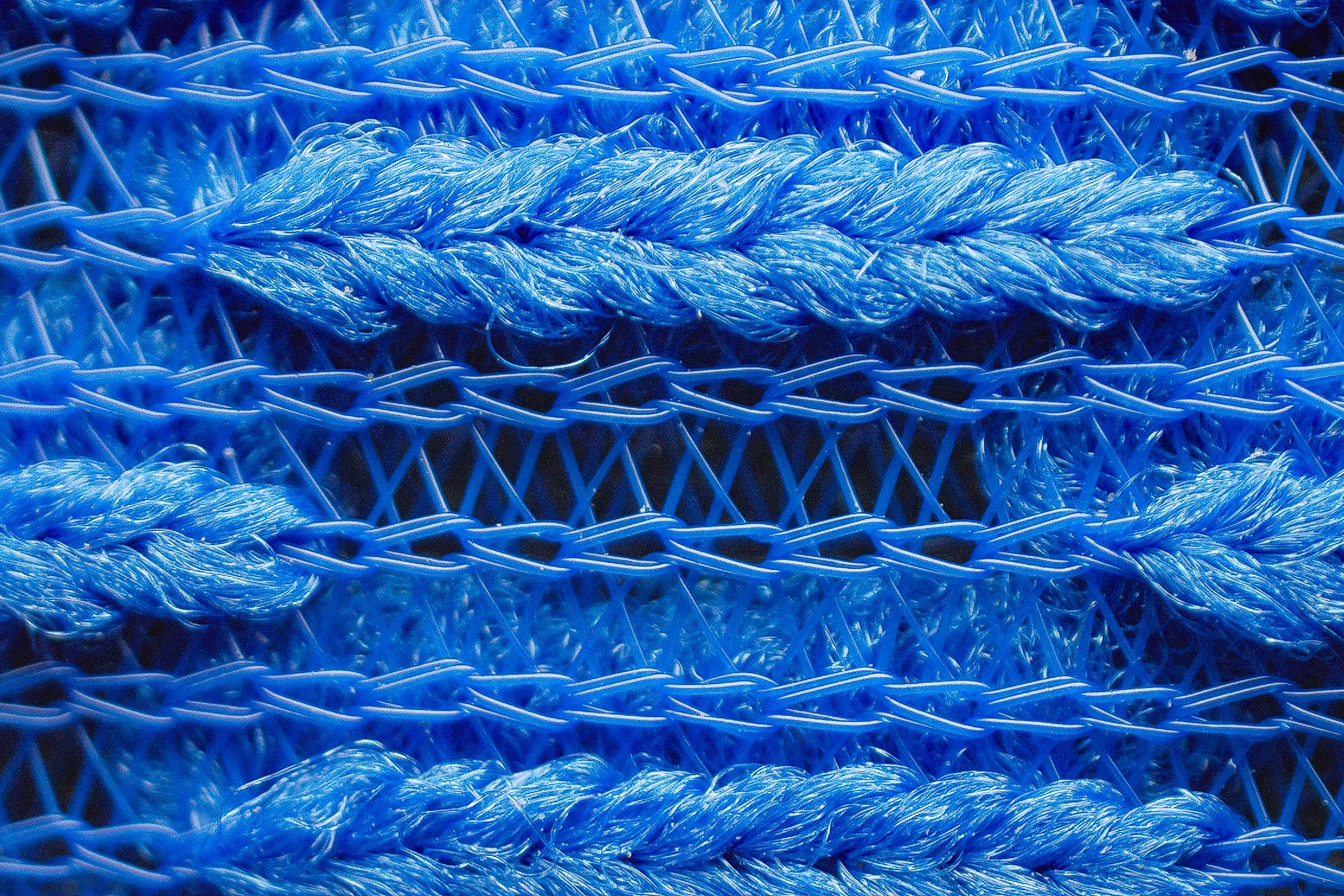
| Alphabounce+ | 3 |
| Average | 3.7 |
Stability
Lateral stability test
Shifting our weight from side to side in the Alphabounce+, we did feel some movement, but the lateral flare of the midsole kept us from feeling like we were going to tip over. This contributes to the stability of the shoe while retaining a level of agility that makes cornering feel smooth rather than clunky as one would expect from such a robust platform.
Torsional rigidity
As is to be expected from a shoe with such a beefy stack, the Alphabounce+ was quite difficult to twist and bend in our hands, leading us to give it a score of 3 out of 5 on our subjective scale for torsional rigidity. This further contributes to the shoe’s stability as it counteracts any natural tendency to roll the foot mid-stride; which makes the Alphabounce+ a good choice for pronating runners as it promotes a more neutral stride.
| Alphabounce+ | 4 |
| Average | 3.5 |
Heel counter stiffness
The Alphabounce+’s heel counter put up a mild level of resistance to us pinching and prodding it, giving it a score of 3 out of 5 on our subjective scale for stiffness. This level of stiffness combined with the heel cup’s shape allows the Alphabounce+ to snugly hold our foot in place while avoiding putting too much pressure on the Achilles’ tendon.
| Alphabounce+ | 3 |
| Average | 2.9 |
Midsole width - forefoot
At 116.9 mm wide at the forefoot according to our caliper, the Alphabunce+’s midsole is quite a bit wider than our current lab average. This gives us plenty of platform to ensure stable landing and toe-offs when forefoot striking.

| Alphabounce+ | 116.9 mm |
| Average | 114.4 mm |
Midsole width - heel
The shoe’s midsole is truly a beast compared to the average shoe at the heel; measuring 103.9 mm wide. This distinctly broad base means that heel strikers will feel rock steady with every landing. Even those with mildly pronating strides will benefit from the Alphabounce+’s stable ride.
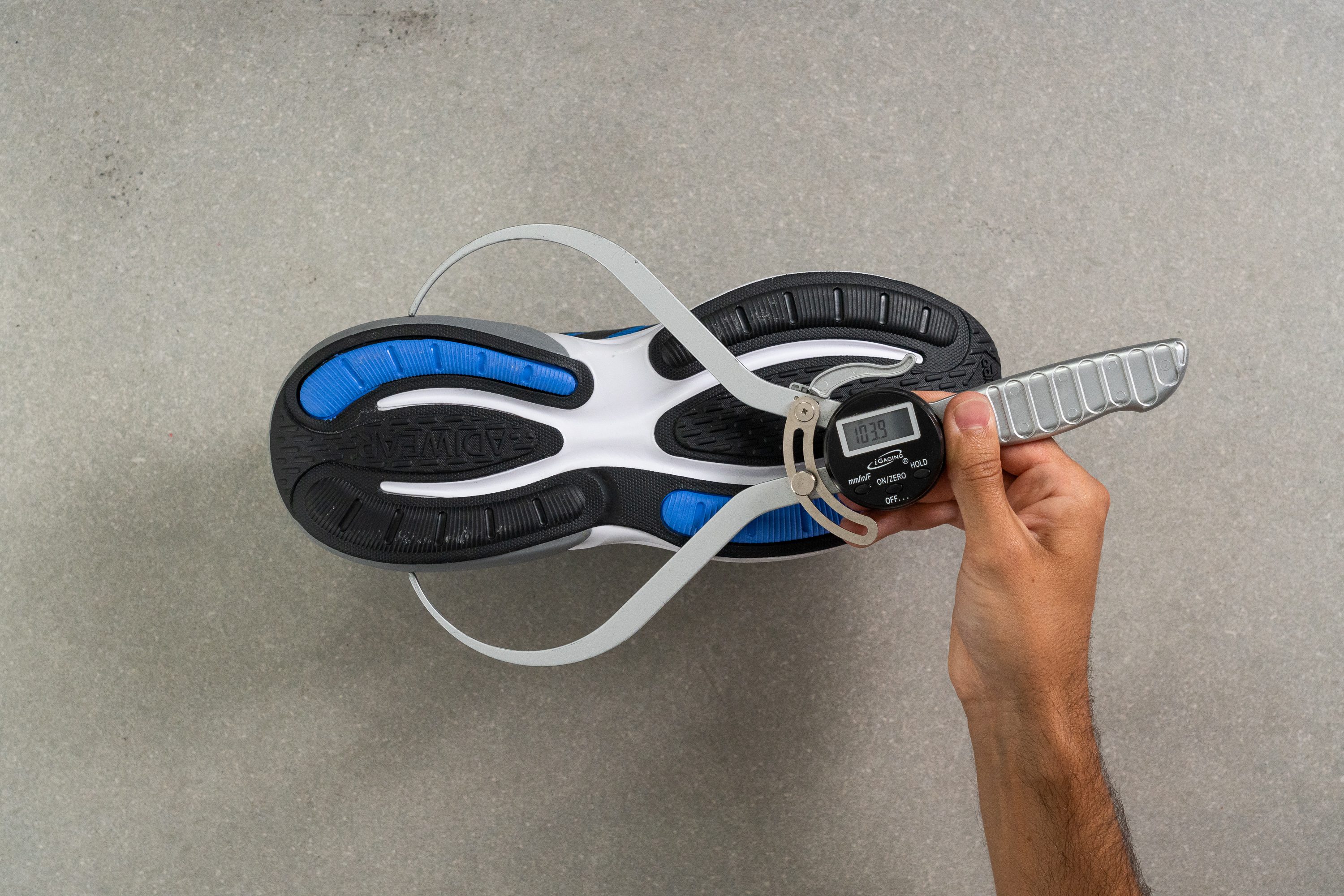
| Alphabounce+ | 103.9 mm |
| Average | 90.7 mm |
Durability
Toebox durability
To test the durability of the Alphabounce+’s toebox, we applied our dremel to it with a force of 3.2N at 10K RPM for four seconds. While the shoe seems to hold up against the tool’s relentless grinding element, it eventually ripped clean through the material and left a hole big enough for a toe to poke through. We therefore give the Alphabounce+ a score of 1 out of 5 for toebox durability.
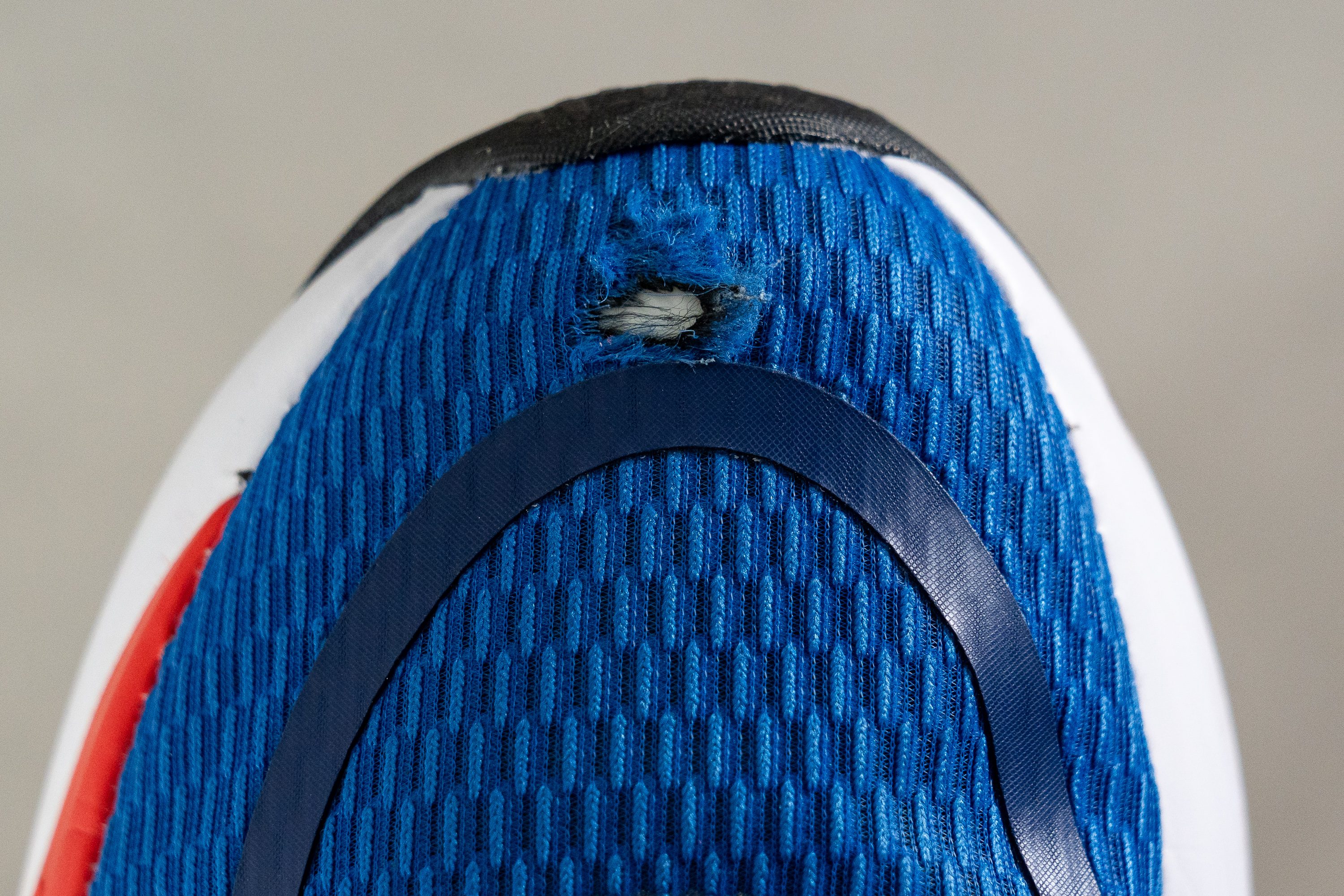
| Alphabounce+ | 1 |
| Average | 2.6 |
Heel padding durability
We performed the same test on the heel counter and found that it didn’t fare any better against our dremel. Padding material was flung about almost as soon as the tool made contact with the shoe’s heel collar, with only an unsightly crater left in the wake of the four second test, earning it a score of 1 out of 5. We therefore don’t recommend going sockless in the Alphabounce+ as incessant friction from sweaty heel rubs will wear out the heel padding in no time.
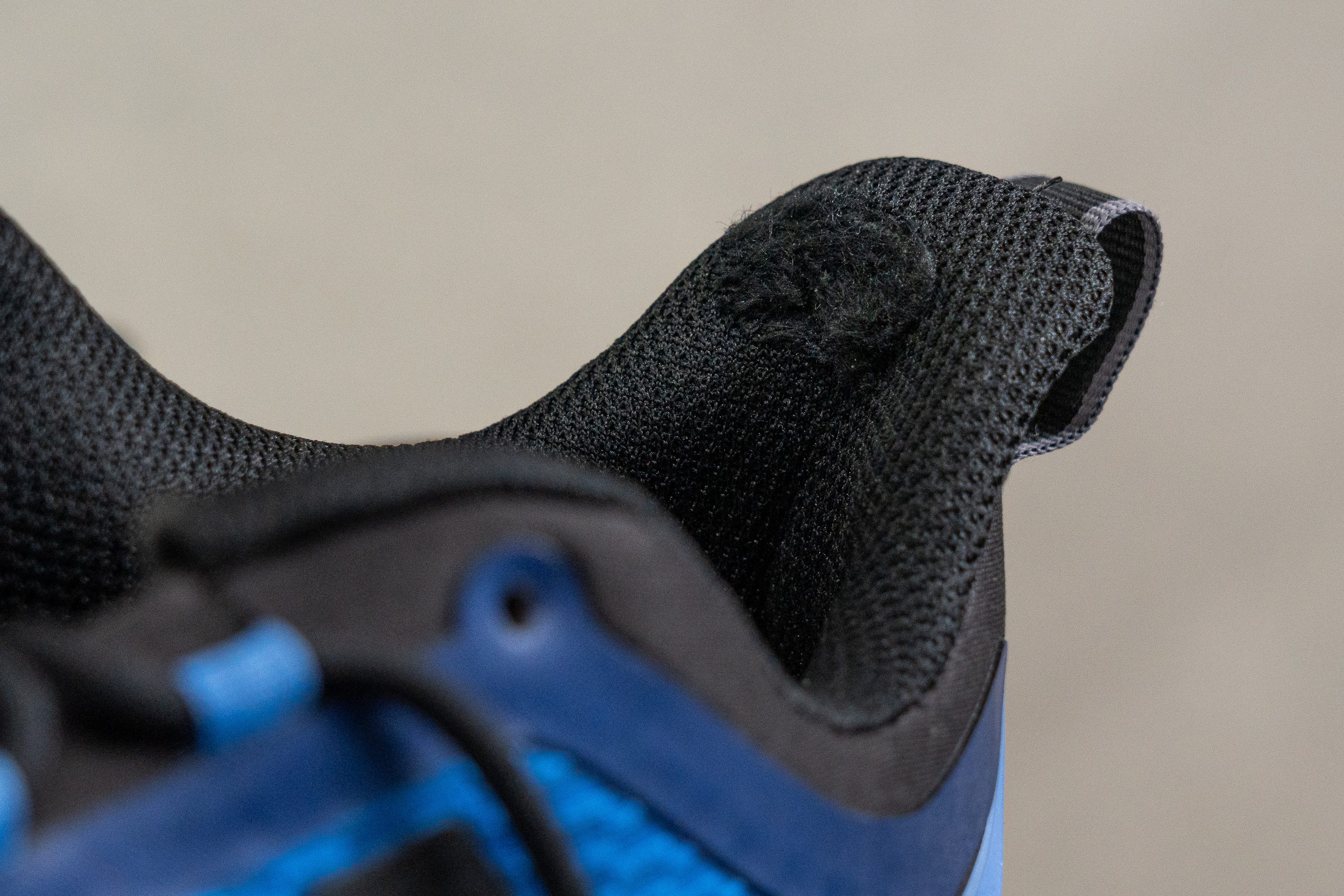
| Alphabounce+ | 1 |
| Average | 3.4 |
Outsole hardness
The Alphabounce+ boasts an incredibly hard outsole which our durometer measured at 87.8 HC. This reading is much higher than our current lab average, which on the one hand factors into the outsole’s durability, while on the other hand sacrificing traction as the shoe is unable to bite into certain surfaces.

| Alphabounce+ | 87.8 HC |
| Average | 79.2 HC |
Outsole durability
We again turned to our trusty dremel to test the durability of the Alphabounce+’s outsole. After grinding for twenty seconds, we had lopped off 0.91 mm of material. Despite this being better than our current lab average, we would have expected an outsole this hard to perform better. This tells us that the outsole material is quite brittle; so while we can safely predict that this shoe will last well beyond 500 miles of normal use, we also wouldn’t be surprised to see significant signs of wear and tear by that point.
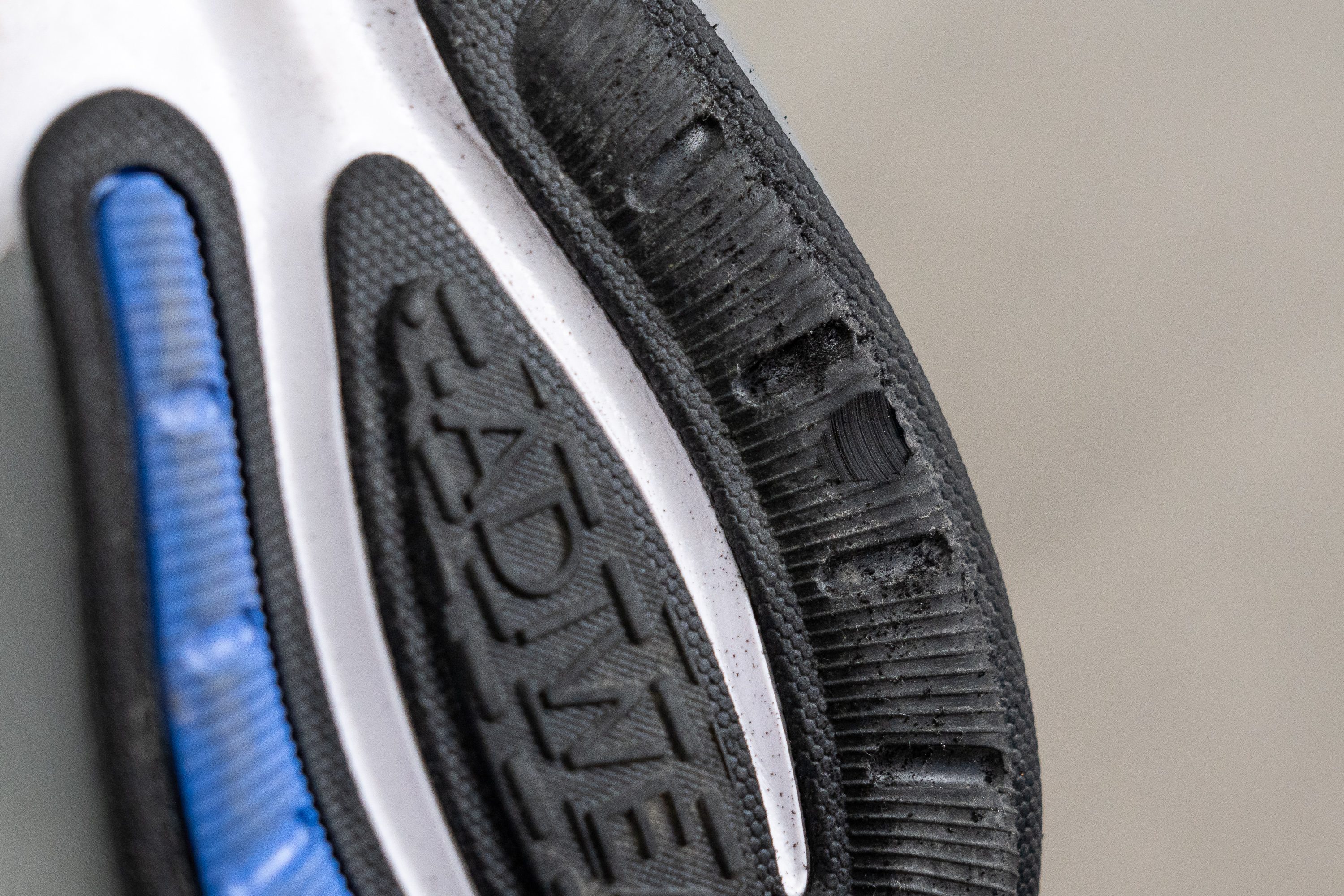
| Alphabounce+ | 0.9 mm |
| Average | 1.1 mm |
Outsole thickness
Further contributing to the longevity of the outsole is how thick it is. At 4.3 mm according to our caliper measurements, the Alphabounce+’s outsole is significantly thicker than that of the average road shoe.

| Alphabounce+ | 4.3 mm |
| Average | 3.2 mm |
Misc
Insole thickness
We measured the Alphabounce+’s midsole to be 3.4 mm thick. This isn’t as thick as our current lab average but still provided us with a soft enough landing surface that complements the shoe’s midsole cushion.
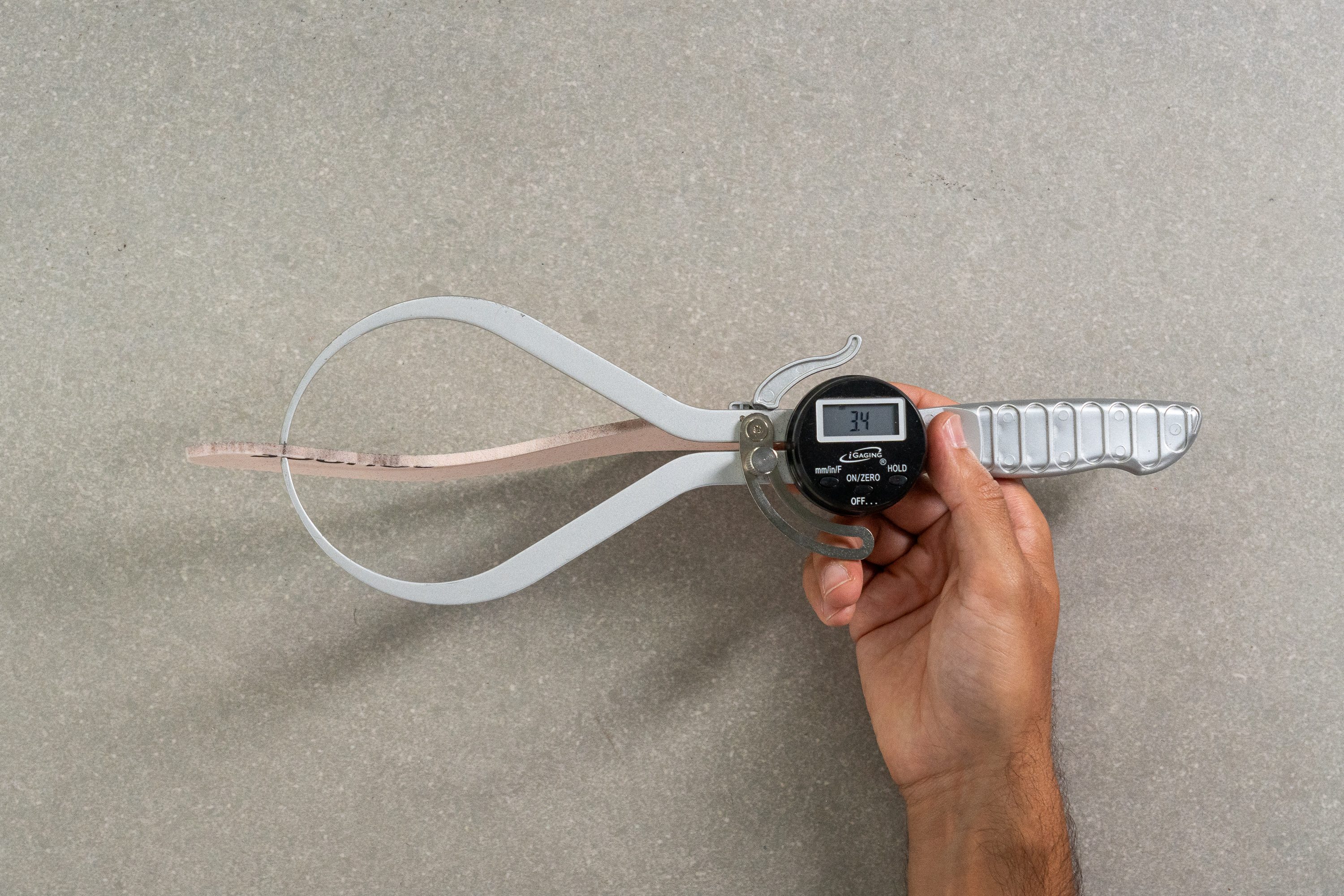
| Alphabounce+ | 3.4 mm |
| Average | 4.5 mm |
Removable insole
The insole of the Alphabounce+ is removable, making it compatible with custom orthotics where necessary.
| Alphabounce+ | Yes |
Midsole softness in cold (%)
To simulate exposure to cold conditions, we put the Alphabounce+ in the freezer for twenty minutes and took another durometer reading of the midsole. With a reading of 26.3 HA, the shoe’s Bounce foam remains softer than our current lab average, which means the the Alphabounce+ will still provide a balanced level of cushioning even on the harshest of winter days.
With only a 17.2% increase in the firmness of the Alphabounce+’s midsole when exposed to cold weather, the shoe performs much better than we expect from a budget daily trainer as it remains well below our current lab average.
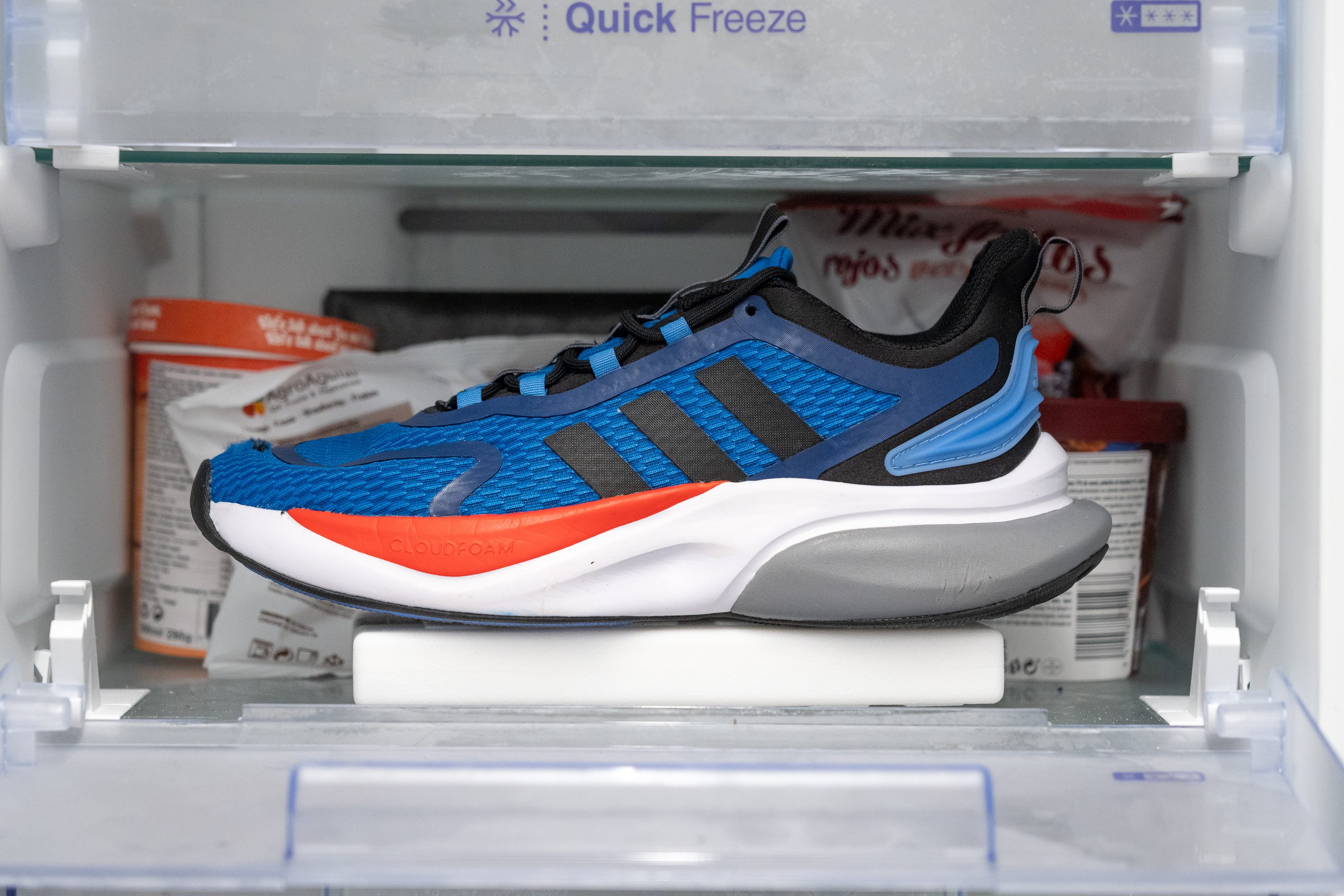
| Alphabounce+ | 17% |
| Average | 24% |
Reflective elements
We recommend sticking to well lit routes when going for night runs in the Alphabounce+ as the shoe features no reflective elements whatsoever.
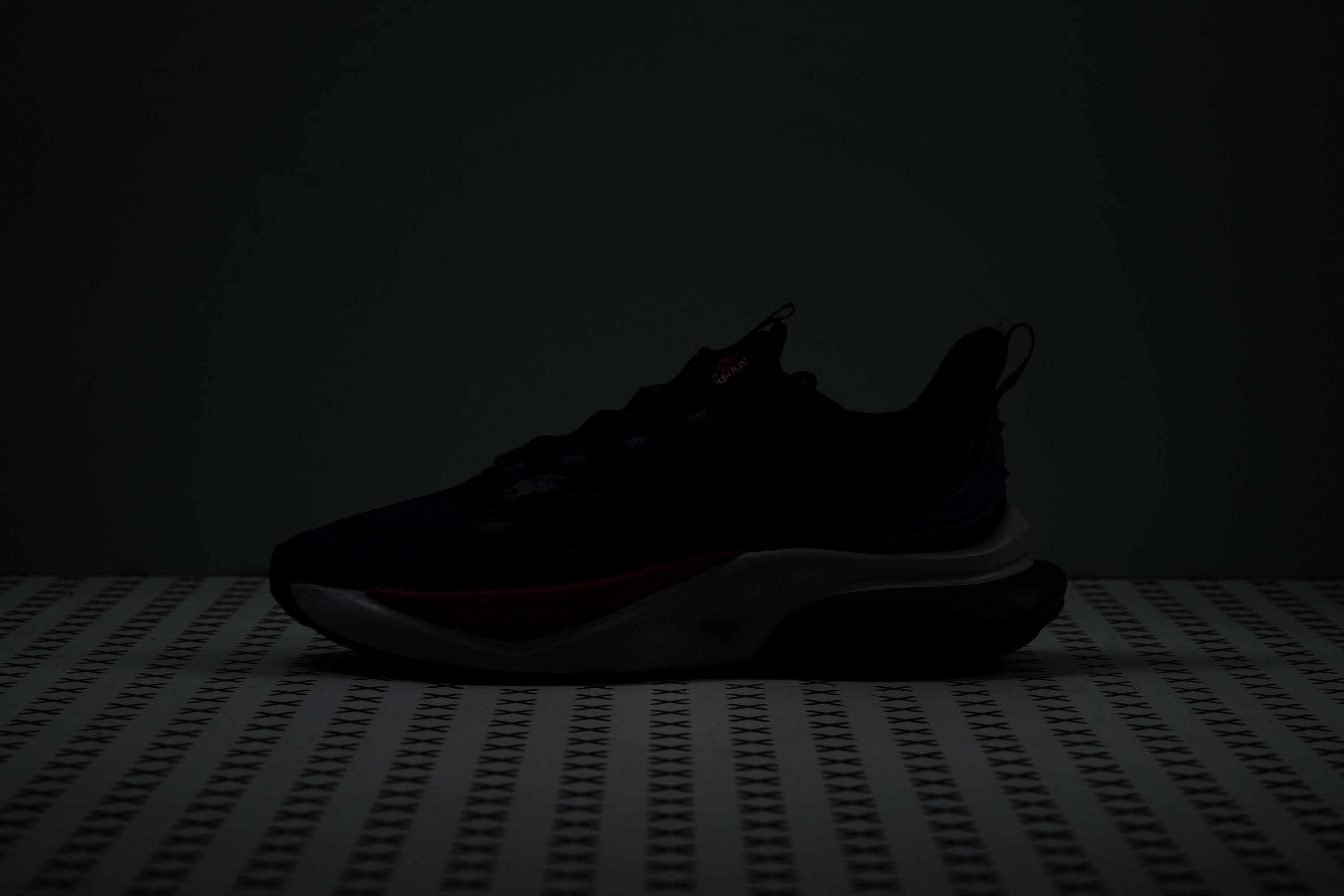
| Alphabounce+ | No |
Tongue padding
Despite being the main vent for heat for the shoe, the Alphabounce+’s tongue is much more generously padded than the average shoe at 7.5 mm according to our caliper. This helped us to achieve a secure and comfortable midfoot lockdown without any hint of lace bite
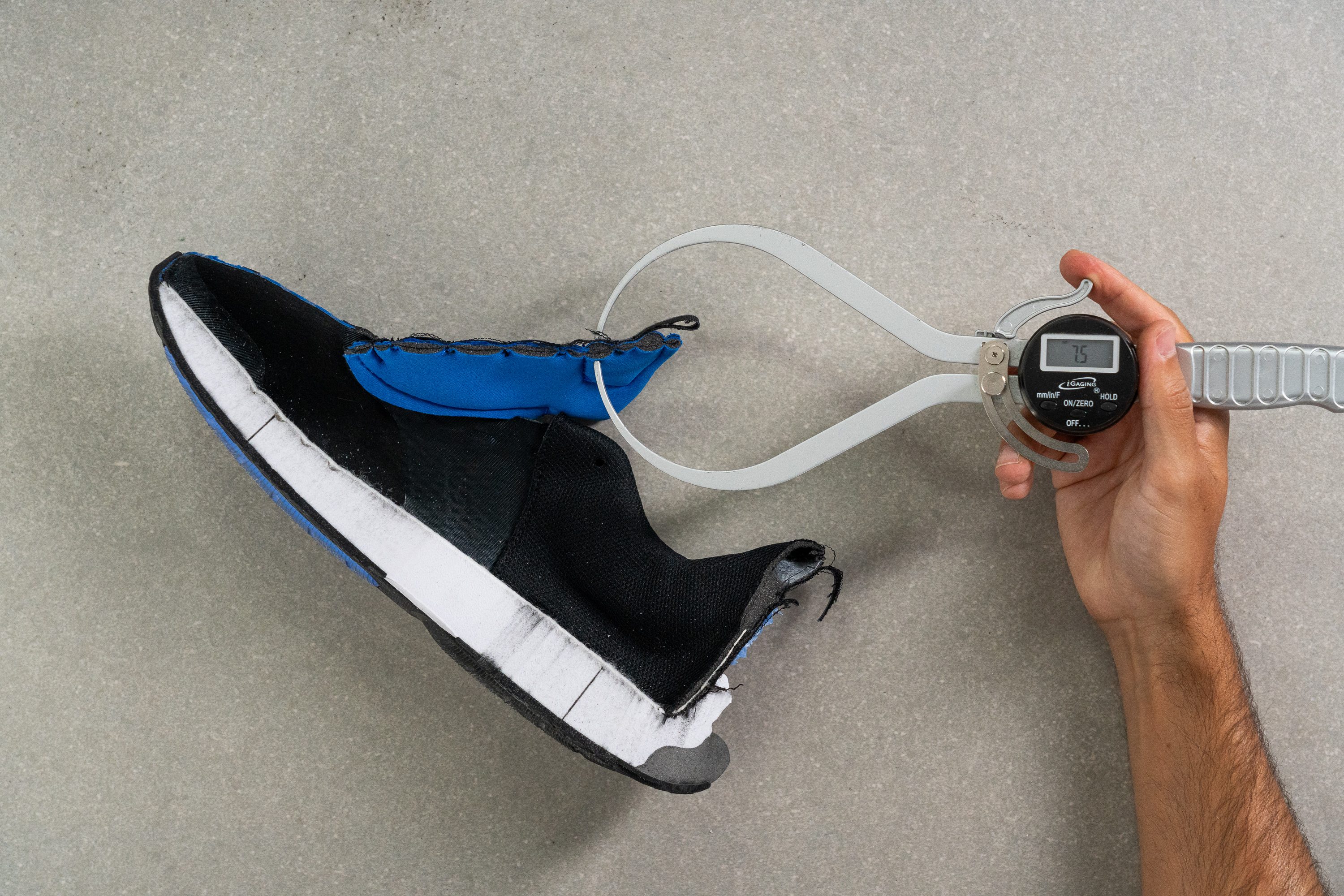
| Alphabounce+ | 7.5 mm |
| Average | 5.8 mm |
Tongue: gusset type
The tongue is non-gusseted, but the plush padding allows the laces to sink into it and prevent any side to side slippage.

| Alphabounce+ | None |
Heel tab
The Alphabounce+ features a finger loop which, combined with the heel’s flared shape, makes sliding the shoe on and off a breeze.
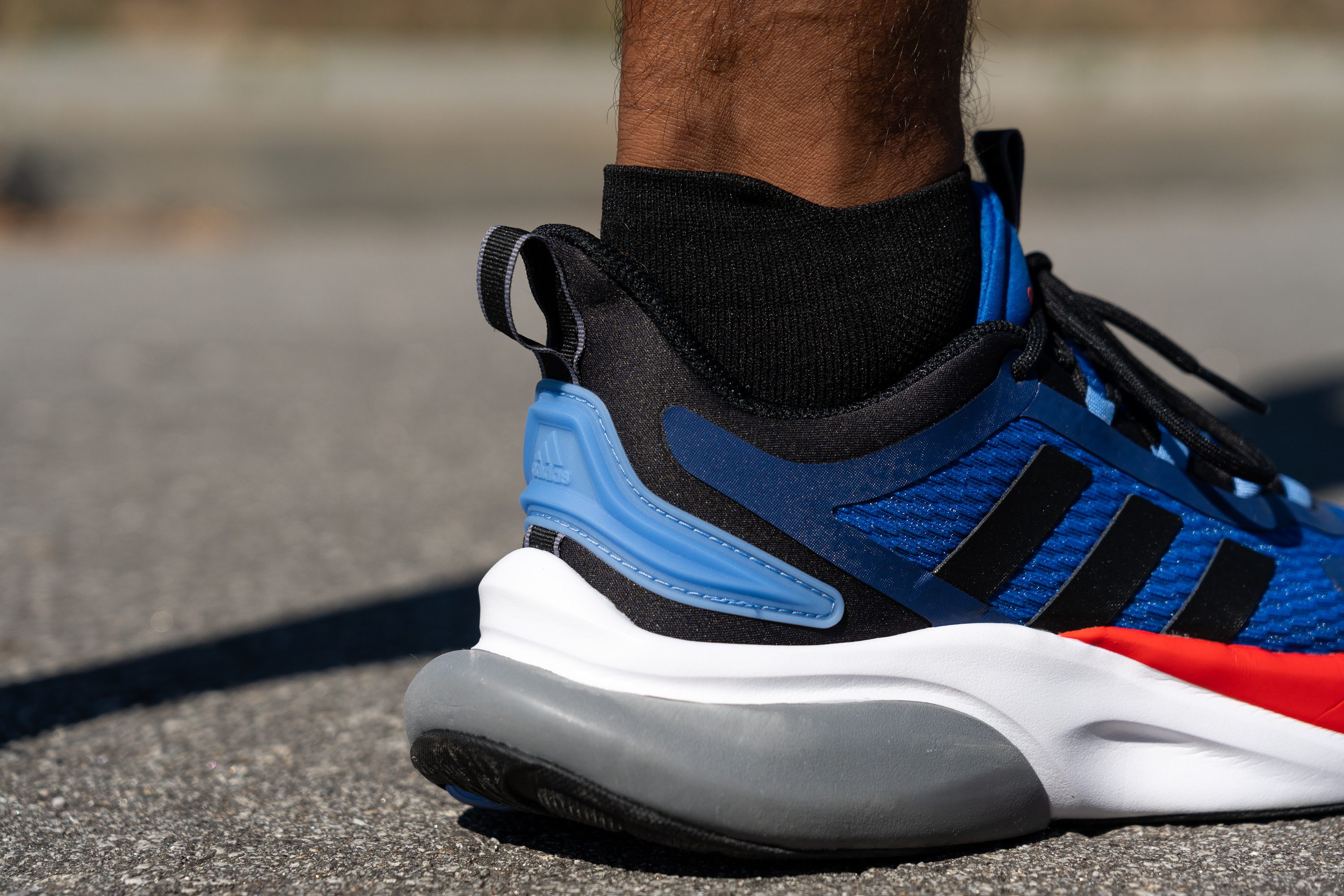
| Alphabounce+ | Finger loop |















































